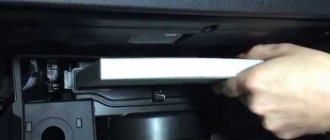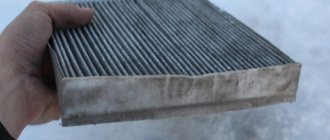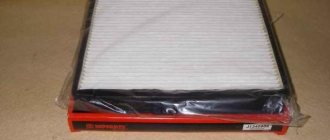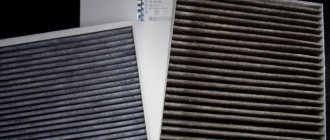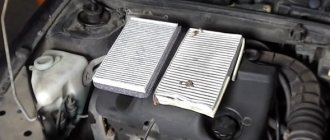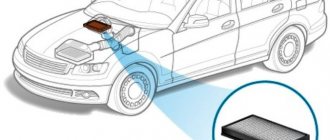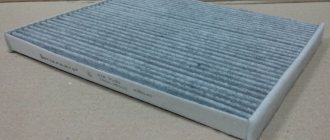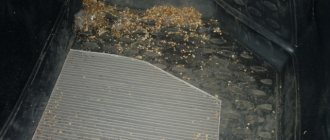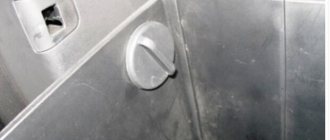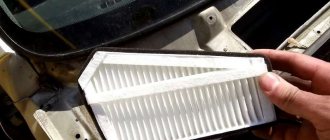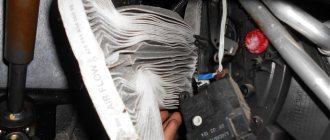Hello, dear friends! There are a huge number of eternal questions in the world. One of them concerns only which cabin filter, carbon or regular, is better, and why.
Nowadays it is almost impossible to find a car that does not have a cabin filter. It is this element that determines what the driver and his passengers will breathe while driving.
When the filter becomes clogged and worn out, increased humidity is felt in the cabin, unpleasant odors appear, the windows actively fog up from the inside, etc.
Accordingly, the consumable requires replacement. The only question is which one to choose and what is the difference between conventional dust filters and carbon ones.
Some believe that this is simply a successful marketing ploy that allows ordinary consumables to be sold at a higher price. Others are confident in the superiority of an element with a carbon layer over a classic consumable. Let's figure out who is right and who is wrong.
Signs of replacing the cabin filter
Knowledge about which cabin filter is better must be supported by regulations for replacing it, and for this, read the instruction manual. Where there is often data on maintenance frequency
But it’s best to additionally pay attention to the typical signs of the need to replace the cabin filter. Indeed, very often, the actual mileage and the actual condition of the filter element are very different from the expected
Cabin dust filter (new/used)
Different car manufacturers give completely different recommendations regarding the period of use and replacement of the cabin filter. Some advise changing it approximately every 10 thousand kilometers, others recommend every 25 thousand
mileage, but experts came to a consensus - first of all, you need to pay attention to the conditions of use, and then decide on the need for replacement
Signs of a clogged cabin filter:
- Fogging of the windshield in the cabin may indicate that the filter is unusable.
- If you notice foreign odors in the cabin (when using carbon filters), it means that it is time to replace it.
- Changes in the microclimate in the cabin, namely an increase in temperature in the summer or malfunctions of the heating system in the winter.
- The inside of the dashboard and windshield gets dirty much faster.
YOU MAY BE INTERESTED: Changing engine oil IN VOLKSWAGEN POLO 1.4.
Carbon cabin filter (new/used)
The main factors for polluting the cabin filter:
- If the car is used in the southern zone, where the climate is high in sand and dust, then in this case the filter needs to be replaced much more often than compared to a car that is used in a region with a cleaner environment.
- If the car is used in a city where there is a fairly dense traffic flow, then the filter will wear out much faster compared to those cars that drive outside the city.
- The presence of various pollen, fluff and insects in the atmosphere, as well as the two previous factors, shorten the service life of the filter element.
The appearance of visible signs is greatly influenced by the operating conditions of the vehicle. Therefore, if the car has been sitting in the garage for a long time or has hardly been driven on country roads, then when the auto repairman says that you need to change the cabin filter, after all, a year has already passed, you need to think about it and see for yourself that this is necessary. Since the price of the original of this element can exceed 2-3 thousand rubles. Which, you agree, is quite a lot.
Let's sum it up
An unambiguous answer to the question: “Which filter should I put in the cabin, carbon or regular?” No. This situation is explained by the goals pursued by the owner of the vehicle. If we compare the advantages and disadvantages of carbon and conventional filter devices, it is obvious that the second type of filter provides only mechanical cleaning of the incoming air flow. And the first option makes it possible to prevent the entry of harmful volatile substances and performs mechanical air purification.
Of course, protecting the interior from dust is important for any car owner. But if you live in a city, you are often stuck in traffic jams, plus in the summer, city residents sometimes observe the formation of smog over the road. All these factors can cause headaches, nausea, and disruption of the nervous system during prolonged contact (staying in a traffic jam). A carbon filter will help to cope with this situation; it can neutralize aggressive substances. But at the same time, this filter element has a short operational period, since the layer of carbon is not very large, and the amount of air passing through it is impressive. A carbon filter is definitely better for a city dweller; if you live in the countryside, you can opt for a regular filter element.
Which filter is better
The most famous manufacturing companies are Bosch and Corteco
Now we will describe several brands that you should pay attention to when choosing
- Bosch. Undoubtedly, a modern company that keeps up with the times. Constantly improving and trying to create better products, focusing on the modern market. The cost of its filters (both regular and carbon) is quite low. Despite their low cost, the filters do not have a particularly high level of quality, however, they cope with the task of air purification relatively well.
- Corteco. The next most popular brand. It is so popular because of its fairly low price and high level of anti-pollution quality. Coal options are worth special attention because they do their job one hundred percent. The cost of conventional paper options is average - and they are not at all different from other filters (they also trap large particles and allow unpleasant odors into the car).
- Raf Filter or Mann Filter. Raf Filter is produced in the Czech Republic, and Mann Filter is produced in China or Russia. Both options are equally good. They cope remarkably well with pollution without allowing harmful substances into the vehicle interior. The Czech company offers antifungal as well as antibacterial options (their level of quality has been tested in practice, so they are deservedly on the list of the best).
- Eiken. One of the oldest filter manufacturers who has done a good job on the quality of their “brainchildren”. Most often they are equipped with Japanese-made cars. During production, a special fabric is used, which allows the filters not to lose their characteristics throughout their entire service life. Quite a budget option.
- Valeo. Expensive, but at the same time high quality and reliable. The company maintains its brand and produces the best materials for vehicle filter systems. By purchasing a cabin filter from this company, you can be sure of its quality, and also forget about the foreign odors that regularly enter the cabin from the street.
- VIC. They protect the interior by 99% from not only large particles, but also various bacteria, including not entirely pleasant odors. They are made from special materials that have a high level of dirt holding capacity. The coating is electret, catching the smallest particles up to one hundred microns in size (smoke, dust, pollen, bacteria, etc.). One of the best options in terms of quality. But from the point of view of cost it will not please you.
- Goodwill, Fram, Mahle. All three of these companies are ranked in the same position because their devices have the same cleaning characteristics. The price is excellent, while the filtering capacity is at a fairly high level.
- Denso. It is in last place. Denso is a Japanese manufacturer. The company's filters do their job quite well, removing odors and filtering the air. However, it still has a long way to go to reach VIC. You will not be pleased with the inflated cost, which clearly does not correspond to the capabilities of this element.
Purpose, operating principle of a conventional filtration element
A typical cabin filter is a white rectangle made of cellulose or synthetic fibers with corrugated paper and laid in certain rows. The material used to filter the air is lower in density than the paper curtain in the air filter device.
Regular cabin filter
A conventional filter installed to purify the air entering the car interior, in addition to dust particles, traps soot, plant particles, and insects. If the filter element has been pre-treated with chlorine, then it is capable of neutralizing certain types of bacteria. When using synthetic fiber to make a filter device, it becomes possible to pass an electric current through it to attract very small particles.
Advantages of a conventional cabin filter:
- filtering large and small particles of debris;
- it is permissible to leave the fan on, even if the car is moving inside a tunnel or in a traffic jam;
- reducing the appearance of condensation on glass;
- filtering allergenic pollen, bacteria, insects;
- affordable price.
Disadvantages of this device:
- does not prevent the penetration of foreign odors;
- does not prevent the entry of harmful, toxic elements.
If you are interested in the question: “Which is better to install a carbon or regular cabin filter?” We recommend watching the video:
Where is the cabin filter located?
In cars, the cabin filter may be located in the inner wall of the glove compartment or behind the center panel of the car. As for the inner wall, in this case you can easily replace it yourself; you just need to remove the fasteners from the glove compartment and remove the element that holds the filter. It's much more difficult with a panel; you can't get there that easily. You not only have to remove the glove compartment, but also move the seat back in order to crawl underneath to the very edge. Other car models are equipped with cabin filters located under the hood in special cassettes.
Not worth buying
AMD filter elements are distinguished not only by their low cost (which you shouldn’t delude yourself with), but also by their low level of quality. In simple words, this filter does not cope with its main task at all: it allows unpleasant odors, dust and other small particles to enter the vehicle. Its only advantage is the price.
Over 15 thousand km, the cabin filter can become even 150 grams heavier. This is the mass of dust that could get into the cabin and settle on interior parts and in the lungs of passengers. What a proof of the usefulness of cabin air filters!
Our fathers and grandfathers did not even suspect that not only the engine, but also... the interior space would be equipped with an air filter in a car. However, for us this is no longer fantasy, but everyday life. True, not everyone knows what filters are and how often they need to be changed.
First, let's take a look into history. Cabin filters appeared in car designs in the early 90s of the last century (they were first equipped with the Mercedes S-Class W140 in 1991) during a period of rapid growth in traffic intensity in developed countries. At first these were ordinary paper filters, similar to engine air filters, then multilayer structures made of synthetic material appeared, in which each layer was responsible for cleaning the air from particles of a certain size. The next stage is carbon cabin filters, in the design of which activated carbon was used. A substrate made of this material, which has been given a porous structure, helps clean the air sucked into the cabin from harmful chemical compounds contained in vehicle exhaust gases. A little later, carbon filters were improved - their design became multi-layered: a paper filter layer, carbon and synthetic fiber with an electrostatic charge. Most modern air purification systems also have an antimicrobial agent added to the filtration system to cleanse the air of germs and bacteria.
Choice theory
The most common cabin filters are synthetic (made of synthetic fibers) and carbon (with layers of synthetic fibers).
When operating a car in megacities, the second option is preferable. If you live in a small town or village and rarely drive in polluted conditions, then a cheaper regular filter will do just fine. However, this option should be abandoned if you or your passengers suffer from allergies during spring and summer flowering. Another advantage of the cabin filter is that it reduces contamination of the air conditioner evaporator radiator
This is very important, as moisture condenses on its surface. This factor, combined with heat and debris accumulating on the surface, provokes the formation of an ideal environment for the proliferation of various kinds of microbes
And during the period of “shedding” of poplar fluff, when the temperature often allows you not to use the air conditioner, but to open the windows, the result of such ventilation will be an abundance of fluff in the cabin. Therefore, it is better to use a standard fan that forces air through the cabin filter.
Activated carbon filter element service life
In general, it is used for about the same time as regular cellulose. True, the coal is depleted after about four months, even if the car has been used little. But even in this case, the filter element itself will work normally, although street odors will begin to make their way into the cabin.
The period of full operation will also be affected by the density of the coal filling. Basically it ranges from 150 to 500 grams. per square meter. Unfortunately, manufacturers of such accessories do not always fully take into account the requirements of car manufacturers and fan power. Therefore, you should not always definitely choose a thicker filter material, since its air permeability may not be sufficient.
Because of this, the efficiency of air conditioning and heating systems may significantly decrease, and the noise level, on the contrary, will increase. More often, however, the opposite situation occurs when the active layer is so thin that, given the high cost of the product, it does not provide better filtration compared to cheap paper analogues.
1200 rub. for the photo report
We pay for photo reports on car repairs. Earnings from 10,000 rubles/month.
Write:
Every car is equipped with a cabin filter, which cleans the air from harmful substances that enter our lungs through the heating, ventilation system or air conditioning when we sit in the car. Many drivers do not pay attention to it; they consider this part not as important as the engine air filter, neglecting to replace it in a timely manner. And then they are also surprised at the origin of the dampness or the unpleasant smell in the cabin. Therefore, we consider it necessary to talk in detail about the types of cabin filters, their characteristics, pros and cons of use.
Which cabin filter is better - carbon or regular?
Many car enthusiasts are wondering which cabin filter is better, a carbon one or a simple one, we will try to answer this question. The fact is that high-quality cabin filters should be made exclusively from synthetic material that will not absorb moisture. Because if this happens, it can not only contribute to fogging and frosting of the glass, but also to the formation of disease-causing fungus and mold on the heater radiator.
If we compare a regular dust and carbon car filter, it should be noted that a regular one can protect only dust, dirt, leaves and insects from entering the cabin, while a carbon filter can cope with more harmful substances, such as exhaust residues and technical fumes liquids. But today, most drivers refuse them, choosing carbon, not only because it has a higher degree of protection, but also because, especially in big cities, the air is very polluted, and a carbon filter can cope with this perfectly. task. That’s why they give preference to carbon cabin filters, despite the fact that their cost is twice as high as regular ones.
Having listed all the disadvantages and features of cabin filters, I would like to say that a simple filter is significantly inferior in its properties to a carbon one. It is also necessary for every car enthusiast to know that the service life of the filter directly depends on the time of its use, even if the car has been used little, the carbon ball in the filter can be depleted in 3-4 months, although the element itself can still perform its functions for quite a long time. The service life can also be affected by the density of the coal filling; it varies from 150 to 500 g. per square meter. But not all filter manufacturers are able to take into account the requirements of the car manufacturer and make filters whose fan power would correspond to their characteristics.
As a result of all of the above, we can summarize that when choosing between a dust filter and a carbon filter, you should give preference to the latter
Although with an ideal selection algorithm, you must first pay attention to the technical characteristics and desired functions, and then to the price. Since the price does not always correspond to the stated capabilities, most often it’s the other way around
Therefore, in order not to harm your body, simply change the cabin filter of your car on time.
A question of cost
If we start purely from the cost and the desire of the car owner to save money, then without any doubt we can say which filter of the two options is better. Or rather cheaper. Dust, created primarily to protect the interior from dust, due to the simplicity of its design, is one of the more affordable products. But coal has a complex structure, multi-layered, which implies high production costs. An increase in cost entails an increase in the price of consumables.
At the same time, even an ordinary anti-dust element can be expensive if it belongs to the premium class category and is manufactured by leading manufacturers using high-quality materials.
The price range for the two types of cabins is very wide. As a result, a motorist can find a part worth 100-150 rubles, but also buy a spare part for more than 3 thousand rubles. It all depends on the manufacturer, the quality of the product, as well as the make and model of the car for which this or that type of cabin is intended.
The most expensive are the original cabin filters, sold under the brand of the car company that produces this or that car. But here it is important to take into account one nuance. Auto companies themselves, for the most part, do not produce consumables at their own factories and enterprises. They sign contracts with large companies that produce their own line of filters. They place orders for the production of consumables with certain characteristics and sizes. And it is the company that cooperates with the automaker that produces batches of cabin filters under the latter’s brand.
As a result, there may actually be two identical filters on the shelf. Only one is enclosed in a box with the inscription VAG (Volkswagen), and the second is in a box with the Mahle Knecht or Bosch logo. It is reliably known that for VAG filter suppliers are Mahle, Bosch, UFI, Hengst Filter, Mann, etc. There will be no difference between them. Just for packaging with the auto company logo you will need to pay 1.5-2 times more.
Therefore, it is categorically wrong to assume that original saloons are always and in everything better than their analogues. There are a number of excellent aftermarket parts that are absolutely second to none in terms of quality and efficiency. Some of them are actually exact copies of the originals.
It is important to be able to manage resources correctly. It is not necessary to spend money on purchasing an original cabin filter. They are expensive, and it is difficult to find objective reasons for such an inflated cost and somehow justify it. It is better to give preference to a non-original from a trusted manufacturer. It is only important that the spare part fits the interior body exactly. But there are no problems with this, since manufacturers of non-original filters clearly sort their products by brands, models and years of production of cars. It is difficult to make a mistake with the choice in our time, given the current opportunities.
Cabin filter brands
Previously, not only customers, but also car manufacturers did not attach much importance to the benefits of cabin filters. Now the situation has changed radically, on the contrary, car manufacturers claim that absolutely all cars simply need filters to protect passengers from harmful substances. And now they offer a huge selection of different types and quality.
To figure out which cabin filter company is better, you first need to familiarize yourself with the country of origin and specialization of a particular manufacturer, and it also doesn’t hurt to read reviews and find comparative tests.
Today the following brands of cabin filters are known:
- The German Corteco filter protects against dust, pollen and ozone. The approximate cost is approximately 600 rubles. The filter surface area is quite large, but the dust transmission coefficient is average.
- The BOSCH filter (Germany) can trap not only dust, pollen, but also bacteria. Price 650 rubles. The filtering surface is impressive, the transmission coefficient is average. In a dirty state, the product showed the best aerodynamic resistance.
- AMD. Approximate price 175 rubles. The filtering surface is smaller than the others. Aerodynamic resistance is normal, but when dirty it is very high.
- MANN-FILTER (Czech Republic), estimated cost 400 rubles. The average dust transmission rate is significantly better than others. Aerodynamic drag in its pure form is the lowest, while in its polluted form it is much higher.
- Knecht MAHLE, manufacturer (Bulgaria), price - 650 rubles. The filtering surface is quite large, the average dust transmission coefficient is very good.
- Russian-Chinese RAF-FILTER, cost 950 rubles. It has three filter layers: antibacterial and antifungal; activated carbon with sodium bicarbonate; blocks many allergens. The surface area of the curtain is average. The aerodynamic resistance of the filter in its pure form is the lowest compared to others. The average pass rate is the best.
- DENSO, made in Japan, cost 1100 rubles. The filter surface area is one of the largest. The average dust transmission rate is quite good.
- FRAM, manufacturer Slovenia, price 370 rubles. The dust transmission coefficient is average.
- GOODWILL, manufacturer China, cost 500 rubles. The curtain area is the smallest of the entire sample.
- Filtron (Poland). Cost 211 rubles. Filtron filters are equipped with a filter membrane made of fully synthetic non-woven material. The dust transmission coefficient is low.
- Russian filter SIBTEK, price 180 rubles. Dust throughput is average.
- Big Filter, price 276 rub. The dust transmission coefficient is high.
- Nevsky Filter. Cost 278 rubles. The dust transmission coefficient is average.
Test results
In terms of efficiency, the LX 2010 filter element (Mahle) showed the best results. This can be explained by the high filtering properties of the material used in its manufacture. And in combination with other parameters, this filter can be considered the best in the entire group of tested samples.
In second place, but only in terms of filtration efficiency, is Fram. Despite the difference of only 0.01%, this example is very far from the first. It showed the lowest dust capacity (107.6 grams). This can be explained by using a material that is too dense for a curtain of this size. With such a high initial resistance as this sample, the result could not have been different.
The Sakura filter showed good efficiency - at the level of 99.2%. But, as can be seen from the dust holding capacity (111 grams), this parameter was achieved due to a significant reduction in the efficiency of the resource. Perhaps, in this case, this result was obtained not due to the parameters of the curtain material, but due to the low filtration area. For this sample it is minimal.
Next in efficiency is BIG Filter with a value of 99.18%. It fell behind third place by 0.02%, but with a mass of accumulated dust of 181.5 grams. In general, a decent result in terms of all parameters.
In fifth place is Bosch with an efficiency of 99.12% and a dust capacity of 135 grams. Such mediocre results can be explained by the poor design of the filter curtain. This sample has the maximum filtration area of all presented. It was achieved due to a large number of corrugations, which during installation leads to a significant compaction of the “pockets” and, as a consequence, high initial resistance and reduced service life.
Filtron result is 99.11%. But its dust capacity is much higher - 144.3 grams. The low dust capacity compared to previous samples can be explained by the small filtration area of the curtain and the material with average parameters.
In seventh place is Champion with an efficiency value of 98.61. This value is on the verge of the permissible value of the final efficiency of a car filter (99%). This result, taking into account the dust holding capacity of 191.1 grams, can be explained by the use of mediocre material for making the curtains - the pores in the paper are too large for this size and design.
The lowest efficiency, to our great surprise, was shown by Mann-Filter - 96.73%. It is difficult to say what caused such poor results from such a well-known brand. In all other respects, the sample looks quite decent. Its dust capacity is simply deafening - 234.6 grams! It is possible that there was a defect in the sample that was not detected during an external examination, so a detailed study is necessary to establish all the reasons. But it is preferable to test a new sample, or even better, three samples, and then draw a conclusion about this model.
Test method
The air filter test bench is built according to the ISO 5011 standard used to test these components - and uses all testing methods.
The filter being tested is installed in its original housing (ideal for testing). Next, using a fan, the injection of rarefied air is simulated, as during normal movement. The air flow should be what the engine uses at rated power.
First parameter
— initial resistance. (auxiliary, directly involved in determining dust capacity) It demonstrates what resistance the filter has to air flow, how “easy it is to breathe” for an engine equipped with such a filter. Its value directly determines the life of the filter element. The higher this value, the lower the resource. The initial resistance depends solely on the design of the engine air path, the size of the window covered by the filter element, the material used to make the curtain, and its parameters (the size of the corrugations and their number). Since the comparative tests used the same housing, adapters and feeder, the factors determining the initial resistance were the curtain material, the dimensions of the corrugations and the quality of workmanship.
Second parameter
- dust capacity. This is, in fact, a resource as such. This parameter has no lower limit. In principle, there is no upper one either, but the higher this indicator, the better. The car manufacturer regulates it with the requirement “not less than...”. The key factor determining this parameter is the filtering surface area of the curtain. As an integral indicator, it evaluates its shape, geometry and dimensions. The second most important factor is the properties of the curtain material (air permeability, average and maximum pore size). The division into “first” and “second” factors is very arbitrary in importance, since they largely influence one another. Geometry is determined earlier during design purely chronologically, which is why in this description this factor is declared first.
Third parameter
— filtration efficiency. It shows how much dust supplied to the input was retained by the filter. The higher this parameter, the better. In terms of significance, it is more important than the previous two; when comparing filter elements, it is rated first, and only with equal efficiency values can these elements be compared in other parameters.
